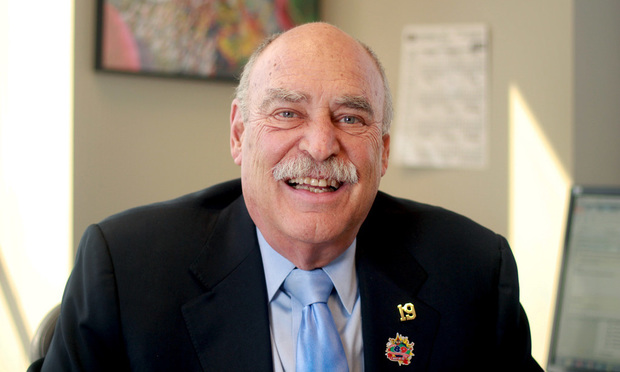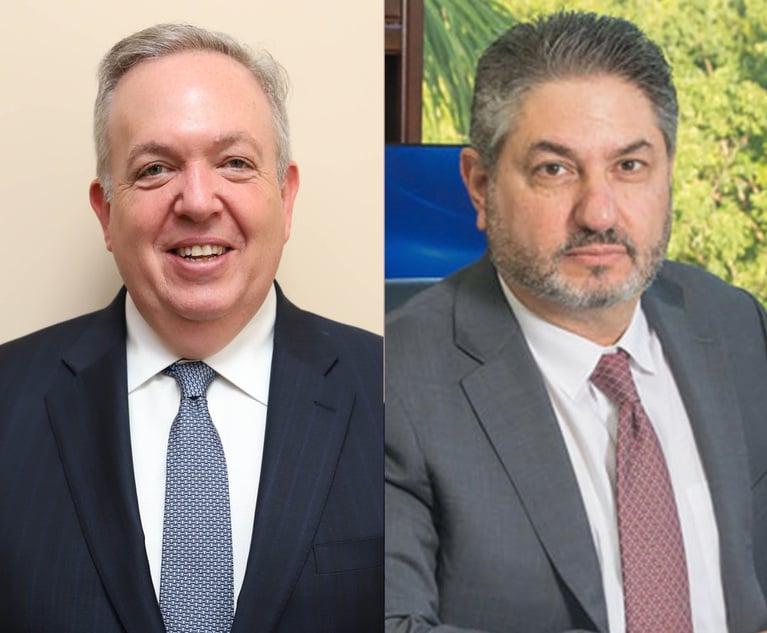Creditors Beware — Bankruptcy Courts Now May Hold Creditors in Contempt
The U.S. Supreme Court ruled a bankruptcy court may hold a creditor in civil contempt for violating a discharge order if there is “no fair ground of doubt” as to whether the order barred the creditor's conduct.
July 15, 2019 at 02:39 PM
5 minute read
 Charles M. Tatelbaum, Tripp Scott
Charles M. Tatelbaum, Tripp Scott
The June 3 opinion by the U.S. Supreme Court in the case of Taggart v. Lorenzen, Executor of the Estate of Brown, provided much-needed guidance in a previously amorphous and uncertain area of the law: determining when a bankruptcy court may hold a creditor in civil contempt for attempting to collect a on a debt that a discharge order immunized from collection. The court in Taggart held that a bankruptcy court may hold a creditor in civil contempt for violating a discharge order if there is “no fair ground of doubt” as to whether the order barred the creditor's conduct; relying on traditional principles of common law contempt in asserting that parties cannot be insulated from a finding of civil contempt based on their subjective good faith while further holding that that a bright-line “strict liability”-like approach is too punitive in nature.
The case concerned Radley Weston Taggart, who invested in a company called Sherwood. Taggart's attempt to sell Sherwood precipitated a dispute between him, other members of the business and the business itself, with the other owners of Sherwood and Sherwood itself arguing that his attempt to sell the business was wrongful. When Taggart filed for bankruptcy, it stayed the litigation for a period. When his bankruptcy case concluded and the litigation resumed, Taggart sought to have the case dismissed on the grounds that he was relieved of his obligations to the creditors (his former fellow owners of the business).
The state court, arguing that it could enter an order clarifying title to the business without violating Taggart's discharge in his bankruptcy case, did not dismiss the litigation notwithstanding Taggart's attempt to do so. Accordingly, the state court entered a judgment that effectively expelled Taggart from the business and, additionally, ordered Taggart to pay the creditors' attorney fees and costs. Taggart immediately returned to the bankruptcy court that granted him a discharge; seeking to have the creditors who continued the litigation in state court held in contempt for violating the bankruptcy discharge on the grounds that his being ordered by the state court to pay the creditors' attorney fees was inconsistent with the discharge of his obligations to the business in the bankruptcy court.
The bankruptcy court denied his request; at which time Taggart appealed the bankruptcy court ruling to the district court, which disagreed with the bankruptcy court; arguing that because Taggart had not voluntarily reentered the litigation (or, to use the words of the line of cases upon which the court relied, “returned to the fray” of the litigation after receiving the discharge). When the case was eventually reviewed by the U.S. Court of Appeals for the Ninth Circuit, it held that the bankruptcy court could not hold the creditors in contempt so long as they had a “good faith belief” that the discharge did not preclude the litigation against Taggart, even if that belief was objectively unreasonable; a finding which did not sit well with any of the nine justices on the Supreme Court.
Most discharge disputes arise in consumer bankruptcies when creditors of the debtor argue that a particular debt was not discharged by a bankruptcy proceeding. The analysis that follows these disputes is usually relatively straightforward: the consumer creditor that sought to collect on a debt would be held in contempt. The procedural history of Taggart produced a situation that is far from typical. Firstly, it involved not a consumer and his various creditors, but seemingly shrewd business persons in an acrimonious battle in which each side was jockeying for a larger share of ownership of an enterprise. As a result, the lessons to be gleaned from the court's analysis of these particular facts can be instructive for creditors and their attorneys alike in their dealings with financially distressed individuals or businesses that have been granted a discharge under the code.
The Supreme Court's holding in Taggart creates an objective standard for creditors and their professionals; particularly those who are unfamiliar with the nuances of the Bankruptcy Code and the policies that underlie many of its debtor-protective mechanisms. In essence, the iteration of the “no fair ground of doubt” standard provides interested parties with an express pronouncement of the court that can be used to properly navigate the tenuous balancing act of, on the one hand, complying with their ethical obligation to seek to extend, modify or reverse existing law (when appropriate) with the legitimate interest of the judicial system (and society at large) in ensuring that subjective beliefs grounded in conjecture or even ignorance of bankruptcy law are not accepted or, worse yet, rewarded by the courts when deciding whether a particular creditor action was violative of a discharge order.
This effect, in turn, is beneficial for creditors and their professionals who are now armed with a clearer conception of what a court may consider to be a violation of a discharge order in that the mistakes of counsel are typically chargeable to the client even where the client merely relies, in good faith, on attorney advice. Additionally, as discharge orders are brought before lower courts post-Taggart, the interpretation of the “no fair ground of doubt” standard will begin to provide more certainty for creditors' rights attorneys and their clients.
In sum, the Supreme Court's “no fair ground of doubt” objective criteria therefore appears to strike a nice balance between the policy concerns of creditors and debtors and the judicial system as a whole in discharge injunction situations.
Charles M. Tatelbaum is a director and Kadeem G. Ricketts is an associate at Tripp Scott in Fort Lauderdale.
This content has been archived. It is available through our partners, LexisNexis® and Bloomberg Law.
To view this content, please continue to their sites.
Not a Lexis Subscriber?
Subscribe Now
Not a Bloomberg Law Subscriber?
Subscribe Now
NOT FOR REPRINT
© 2025 ALM Global, LLC, All Rights Reserved. Request academic re-use from www.copyright.com. All other uses, submit a request to [email protected]. For more information visit Asset & Logo Licensing.
You Might Like
View All
SEC Whistleblower Program: What to Expect Under the Trump Administration
6 minute read
Turning the Shock of a January Marital Split Into Effective Strategies for Your Well-Being
5 minute read

Trending Issues in Florida Construction Law That Attorneys Need to Be Aware Of
6 minute readTrending Stories
Who Got The Work
J. Brugh Lower of Gibbons has entered an appearance for industrial equipment supplier Devco Corporation in a pending trademark infringement lawsuit. The suit, accusing the defendant of selling knock-off Graco products, was filed Dec. 18 in New Jersey District Court by Rivkin Radler on behalf of Graco Inc. and Graco Minnesota. The case, assigned to U.S. District Judge Zahid N. Quraishi, is 3:24-cv-11294, Graco Inc. et al v. Devco Corporation.
Who Got The Work
Rebecca Maller-Stein and Kent A. Yalowitz of Arnold & Porter Kaye Scholer have entered their appearances for Hanaco Venture Capital and its executives, Lior Prosor and David Frankel, in a pending securities lawsuit. The action, filed on Dec. 24 in New York Southern District Court by Zell, Aron & Co. on behalf of Goldeneye Advisors, accuses the defendants of negligently and fraudulently managing the plaintiff's $1 million investment. The case, assigned to U.S. District Judge Vernon S. Broderick, is 1:24-cv-09918, Goldeneye Advisors, LLC v. Hanaco Venture Capital, Ltd. et al.
Who Got The Work
Attorneys from A&O Shearman has stepped in as defense counsel for Toronto-Dominion Bank and other defendants in a pending securities class action. The suit, filed Dec. 11 in New York Southern District Court by Bleichmar Fonti & Auld, accuses the defendants of concealing the bank's 'pervasive' deficiencies in regards to its compliance with the Bank Secrecy Act and the quality of its anti-money laundering controls. The case, assigned to U.S. District Judge Arun Subramanian, is 1:24-cv-09445, Gonzalez v. The Toronto-Dominion Bank et al.
Who Got The Work
Crown Castle International, a Pennsylvania company providing shared communications infrastructure, has turned to Luke D. Wolf of Gordon Rees Scully Mansukhani to fend off a pending breach-of-contract lawsuit. The court action, filed Nov. 25 in Michigan Eastern District Court by Hooper Hathaway PC on behalf of The Town Residences LLC, accuses Crown Castle of failing to transfer approximately $30,000 in utility payments from T-Mobile in breach of a roof-top lease and assignment agreement. The case, assigned to U.S. District Judge Susan K. Declercq, is 2:24-cv-13131, The Town Residences LLC v. T-Mobile US, Inc. et al.
Who Got The Work
Wilfred P. Coronato and Daniel M. Schwartz of McCarter & English have stepped in as defense counsel to Electrolux Home Products Inc. in a pending product liability lawsuit. The court action, filed Nov. 26 in New York Eastern District Court by Poulos Lopiccolo PC and Nagel Rice LLP on behalf of David Stern, alleges that the defendant's refrigerators’ drawers and shelving repeatedly break and fall apart within months after purchase. The case, assigned to U.S. District Judge Joan M. Azrack, is 2:24-cv-08204, Stern v. Electrolux Home Products, Inc.
Featured Firms
Law Offices of Gary Martin Hays & Associates, P.C.
(470) 294-1674
Law Offices of Mark E. Salomone
(857) 444-6468
Smith & Hassler
(713) 739-1250






